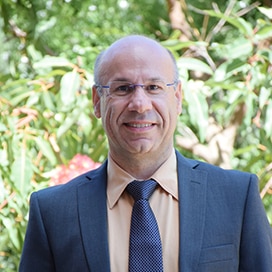Doctor Vincent Bulone
No Single TechniqueResearch lab uses an array of Agilent instruments to address complex questionsThe research that Vincent Bulone and his colleagues are doing at the University of Adelaide has a range of applications—and requires a range of instruments. Delving deeply into plant biology—particularly cell wall structure and metabolism—they are eager to devise new ways to improve plants for human consumption, and make humans healthier.
"The challenge is that carbohydrates, especially the carbohydrates that form cell walls, are probably the most heterogenous biomolecules on earth," Bulone says. "In most cases, for a single type of carbohydrate, you get a whole range of molecules with different masses, different sizes, and different structures. This makes them extremely complicated to study."
Which is why his lab, Adelaide Glycomics, is partnering with Agilent. "We need very powerful analytical technologies to understand the structure and the biosynthesis of these complex carbohydrates," Bulone says. The lab incorporates gas and liquid chromatography systems along with various forms of mass spectrometry (quadrupole time-of-flight, triple quadrupole, and ion mobility), not to mention an infrared microscope.
"There is no way to determine the structure of complex carbohydrates, or any molecule, with just a single technique," he says. "That’s why we need this range of instruments. They are all nicely complementary. There is no duplication here in the information we get."
Even Bulone’s research in a single area—crop protection—is multifaceted. "There are several ways of doing that," he says. "You can modify the plants by making GMOs, which is not widely accepted, or you can use natural ways, like breeding technologies, to introduce new properties in plants. It usually takes longer but it works as well." While looking for ways to make plants stronger and more resistant to disease, Bulone is also looking for ways to make crop-destroying diseases (microbial pathogens) weaker. "There are different ways of doing that as well," he says. "The approach we are using is to try to prevent cell wall formation in the pathogens. This is exactly how penicillin works: It blocks the formation of the cell wall in bacteria, which kills the bacteria, so we are trying to use similar approaches to fungal pathogens to protect the plants they infect. We are trying to understand how the enzymes that synthesize the cell wall carbohydrates in pathogens work. Once we understand this, we should be able to design new inhibitors that target these enzymes and that will prevent the formation of cell walls." Bulone notes that, when a pathogen infects a plant, the plant tries to respond—and various signals are exchanged between the plant host and pathogen.
"If we can understand this mechanism, we may be able to develop processes that interfere with the virulence of the effectors that are produced by the pathogens, but also increase the immune response of the plant, which all together would lead to a higher protection of the plant against the infection," he says.
Bulone and his colleagues hope that what they learn will one day be used to increase crop yields and feed a hungry world. Even preventing the loss of crops to emerging diseases could have a huge impact. "In 2011, for instance, if we had been able to prevent five of the major crop diseases, it would have been enough to feed around 800 million people around the planet," he says. "Some of the disease outbreaks can destroy 80 to 90 percent of a specific crop, so it can go much beyond what I just said." In addition to making plants healthier, Bulone and his colleagues want to make the people who eat them healthier, too. "We are trying to understand how carbohydrates, especially dietary fibers, are synthesized in cereal crops, to eventually improve their properties because some of them have a beneficial impact on health, particularly the microbiota—the collection of helpful bacteria we have in our guts," Bulone says. "There is more and more evidence that the amount and quality of the dietary fibers in the vegetables and fruits we eat have an impact on gut health. So, what we have been trying to do is to understand what kind of structures have positive effects, then to eventually manipulate the plants to improve their quality for human nutritional purposes."
|

Vincent Bulone, PhD
Director, Australian Research Council |
Selected publications
|
Genetic and environmental factors contribute to variation in cell wall composition in mature desi chickpea (Cicer arietinum L.) cotyledons.
The Impact of Steroidal Glycoalkaloids on the Physiology of Phytophthora infestans, the Causative Agent of Potato Late Blight.
Spatially resolved transcriptome profiling in model plant species.
Comparative analysis of sterol acquisition in the oomycetes Saprolegnia parasitica and Phytophthora infestans. |